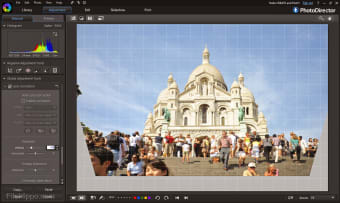Regrettably most people will ignore the 18 page manual included in the boxed version. Too bad because it is quite informative and a single read would leave the first-time user much better equipped to get the most out of PhotoDirector. The manual is also available at any stage within the program by simply pressing the F! Need a manual for your CyberLink PhotoDirector 5? Below you can view and download the PDF manual for free. There are also frequently asked questions, a product rating and feedback from users to enable you to optimally use your product. If this is not the manual you want, please contact us. Our database contains more than 1 million PDF manuals from more than 10,000 brands. Every day we add the latest manuals so that you will always find the product you are looking for. It's very simple: just type the brand name and the type of product in the search bar and you can instantly view the manual of your choice online for free. PhotoDirector is a registered trademark along with other company and product names mentioned in this publication, used for identification purposes and remain the exclusive property of their.
Introduction


Cyberlink have unleashed their fifth instalment of PhotoDirector; the photo tagging and editing system. With thirteen new features such as Bracketed HDR, Auto lens correction and Split toning, PhotoDirector 5 appeals to the photographer looking to add professional looking results to their photography. It costs £79.99, or £59.99 if upgrading from version 4.
Features

We installed Cyberlink PhotoDirector 5 from a dedicated FTP server, but it's possible to either download from the Cyberlink website or purchase a hard copy. If you download from the website you can try the program on a 30 day trial.
There are two versions to PhotoDirector 5: Ultra and Suite. Despite Ultra sounding like the premium option, it's actually the more basic of the two. The reasoning behind this is that the Suite also contains ColorDirector Video Grading tools. Incidentally, six of the new features are contained in this program. So if you only get the Ultra version, you'll miss out on nearly half of the new features. Still, it's only an extra £20 and video is a big part of photography these days, so even if you're not thinking about using video just now, it could happen in the future.
Version 5 is laid out in the same tried and tested way that version 4 was and version 3 etc. If this is your first time with a PhotoDirector program, it's split into five sections. The initial section (Library) is designed to file and categorise all your pictures that you flow through. Import your images through the File drop down at the top of the page. You can import an image, an entire folder or even direct from a tethered camera.
Importing a photo
Importing images into Cyberlink PhotoDirector 5 as a folder will bring up a window for you to select whether you want to import every one or cherry pick your favourites. You can then add any filter presets, a copyright to place in the EXIF data and tags for finding them at a later date. You can also rename them if you don't have your camera set to continuous scrolling on the file numbers. It took moments to import 96 TIFF files but all the images weren't ready as thumbnails in the preview ticker below at this stage. Below the Library tab are two more tabs. The left is default open, titled Project. It shows the file path that your images have taken to get loaded into PhotoDirector. Click on Metadata and all the EXIF data from the highlighted image (shown in the main preview window) will appear on screen. This will include the copyright if you added it and the tags at the bottom.
Metadata
Once all your images are tagged and copyrighted, you can move onto the Adjustments tab. There are two sub-sections to this, just like in the Library, but called Manual and Presets. The program defaults to Manual, but if you don't have time, you could use the many preset effects in already loaded on. This is what we like about PhotoDirector. In some other programs, you'll only get six to 12 preset filters unless it's filter software. PhotoDirector has over 40 with the option to download others if you want to. If you have the time and inclination, though, you can always sit and edit each picture manually as there's no batch process option.
Selective Colour Eraser
There's the option of adjusting regional areas such as red-eye, cropping or doing a bit of spot removal. On a more global scale (the entire photograph), you can change the white-balance temperature, contrast, saturation and clarity as well as adding a HDR effect or messing with the levels. The HDR effect isn't like a true HDR image, which is why they call it an effect. It's easy to think that the effect will replicate a HDR image precisely, but it can't generate detail in shadow areas that wasn't there in the first place. Likewise, it can't clip burn out when there was nothing there on the sensor for it to replace the burn out with.
Content Renover Before
Content Renover After
Photodirector 5 Manual User
Your Comments
Please enable JavaScript to view the comments powered by Disqus.Photodirector 8 Manual
